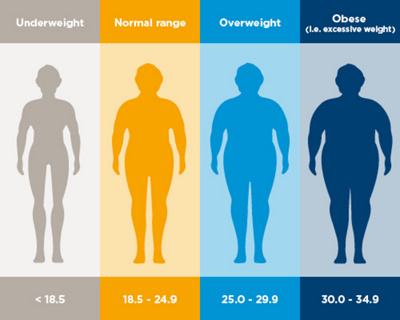The Body Mass Index (BMI) signifies the correlation of your body weight to your height. This reference number is a significant indicator for preventive health care measures. Utilize our free BMI calculator to gauge your unique BMI and determine whether it falls within the acceptable range or if it veers towards being excessively high or low.
Calculate your BMI
What does "BMI" mean?
The body mass index (BMI) is a statistical figure indicating the ratio of height to weight. Calculating the BMI is a quick and simple way of assessing a person's weight based on guide values.
The BMI acts as a rough guide for the ideal weight of an individual. It does not, however, take account of their build or the ratio of fat to muscle. It is a standard value and a quick and easy way of assessing a person's weight, so avoiding a health risk from being under- or overweight.
The BMI cannot be applied to children, older persons or people who do a lot of sport as their body mass differs from average values.
BMI table*
| BMI table* | |
|---|---|
| BMI | Weight category |
| Under 18.5 | Underweight |
| 18.5 - 24.9 | Normal range |
| 25.0 - 29.9 | Pre-obese |
| 30.0 - 34.9 | Obese class 1 |
| 35.0 -39.9 | Obese class 2 |
| Over 40 | Obese class 3 |
* Source: World Health Organization Europe
How is the BMI calculated?

The body mass index is based on a simple mathematical formula: It is calculated by taking the body weight in kilograms and dividing it by the square of the height in metres:
BMI = weight (kg) / height (m)2
Example of a calculation
A man is 1.85 metres tall and weighs 90 kilograms. This is how his BMI is calculated: 90 (kg) divided by 1.85 (m)2; the result is 26.3.
On the other hand, a woman 1.63 metres tall and weighing 53 kilograms has a BMI of 19.9.
The age of a person also influences the assessment of their BMI as body weight generally increases as they become older. For this reason, different assessment tables listing other values for the individual age groups are used for adults.
How should the BMI result be evaluated?
Tables drawn up by the World Health Organization (WHO) are used to evaluate the body mass index. They list different guide values depending on age.
Each BMI table always shows four main categories:
- Underweight
- Normal range
- Overweight
- Obese (i.e. excessive weight)

These categories are then broken down into different degrees and levels of severity. A total of eleven weight classes can be shown here.
Identifying you are underweight
If your BMI is below 18.5, you are underweight. As the body is at risk of deficiency here, such persons have an increased risk of cardiovascular disease and osteoporosis. The body's metabolism and immune system may also be impaired. The BMI helps to identify all such risks to health in good time and reduce them. It allows people at risk to document their progress towards an ideal weight – for example, by getting more exercise and changing their diet.
Normal weight
Normal weight for Body Mass Index is usually between 18.5 and 24.9 and is considered healthy. Within this category, you are statistically less likely to develop certain diseases.
Identifying you are overweight
Not every pound of excess weight will make you ill, but permanently being overweight increases the risk of numerous diseases including osteoarthritis, arteriosclerosis, high blood pressure, diabetes and various types of cancer. It can lead to breathing difficulties and joint pain, in addition to disorders of the metabolism and sex hormones.
What BMI at what age?
Assessment of the body mass index also depends on the age of the individual. As the bodies of children and adolescents develop neither uniformly or in synchrony, the BMI cannot be used for young persons.
As people age, their proportion of body fat generally increases, which is why different guide values apply to the various age groups. With older people, the BMI is not applicable as no average ratio can be set between height and weight due to the personal development of each individual.
| BMI table* by age | |
|---|---|
| Age | Optimum BMI |
| 19-24 | 19-24 |
| 25-34 | 20-25 |
| 35-44 | 21-26 |
| 45-54 | 22-27 |
| 55-64 | 23-28 |
* Source: National Research Council
The BMI cannot be used to assess the health of sports people either, as the ratio of height to weight is distorted by their above-average muscle mass. In this case, the proportion of body fat is a more meaningful guide.
